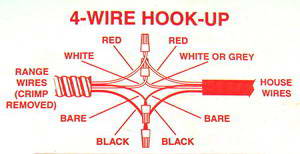 |
Question:
Can a Oven Circuit be Used for a Water Heater?
Glen asks: I have a 220 volt circuit coming in to my oven, can I use that line
to provide power for a water heater?
Answer:
No, you cannot do this. Each of these devices needs to have their own dedicated circuit of power, and they both have their own specified amount of power. The water heater requires a dedicated 30 amp 240 volt circuit. Placing the water heater on the same circuit as the oven will overload the oven circuit and cause it to trip the circuit breaker off.
Question:
What are the Wiring Connections for a 240 Volt Oven?
Daniel asks: I have a 1980's Home, with a 3-wire 240 volt circuit which is Aluminum. I would like to know how to connect his cable to my new stove.
The Cable Wires are:
1-black insulation, 1-black with 2 red lines insulation and a bare ground.
Does the black wire with red lines go to red on stove? Does it matter if the 2 hot are switched?
Answer:
Daniel, here is the typical 240 volt wiring connections:
Circuit Black wire to Black wire of the Oven.
Circuit Black with Red to Red wire of the Oven.
Circuit Ground, Green or Bare wire with Oven Green or Bare.
* It does not matter if the Black and Red wires are reversed with 240 volt oven wiring.
* Some 4-wire ovens do permit bonding the White Neutral wire to the Ground wire. Check the Electrical Connections in your installation manual to be sure.
Oven Circuit Wiring
How to Wire a 240 Volt Oven Circuit: Kitchen Oven Electrical Wiring and Circuit Requirements.
How to Wire a New Oven When Replacing an Existing Oven: What to do when you have black wire, red wire, white wire, and a ground wire.
How to Identify the Oven Wires when Replacing an Oven: Connecting the Electric Wires for an Oven.
New and Updated about: Wiring an Oven
Question from Greg, a Handyman from Tigard, Oregon:
Is it OK to install a new 4-wire oven, with black, red, white and green wires?
I just removed a wall oven in a house built in 1994. I discovered that the supply to the junction box for the oven (on its own separate circuit) is Type SE 8AWG aluminum, with two black wires and the neutral being the twisted-strand insulated type. It is my understanding that NEC allows me to install a new 4-wire oven, with black oven wire to black, red oven to black, and white/green oven to insulated. Also, that I should coat the connections with an anti-oxidizing compound and use special purple wire nuts. Is this correct?
Dave’s Answer:
Greg, This depends on the oven that you have. Some ovens require a separate insulated neutral wires and a ground. Consult the installation manual that came with the oven for specific details.
Anti-corrosion compound is required when splicing aluminum and copper wires together, and the wire connector must be UL Rated for AL/CU wires.
Question from Rod, a Homeowner in Woodsboro, Maryland:
What are the proper wire connectors that should be used when hard wiring a double wall oven?
This is a new kitchen renovation and I am replacing old aluminum wiring with 6 AWG copper 4-wire on 50 amp 240 volt breaker. Should I be using a block splice with shrink tubing? A copper split bolt seems bulky? Even the largest wire nuts seem inappropriate. Is a 4″ box large enough, those wires are not very flexible. I will be doing the same type of hook-up for an induction cooktop.
Dave’s Answer:
The large blue connectors are typically used to make the connections for the oven wires to the oven circuit wires. Be sure to trim the insulation back and join the wires together side by side and then apply the wire connector by twisting in the clockwise direction. Install a junction box that has the required cubic inches for the total number of wires that will be enclosed inside the box.
Question from Joe, a Homeowner from Inarajan, Guam:
Which cable should I use for an oven circuit?
What number Romex wire do I use to install an oven? What is the correct amperage?
What is the required Romex wire?
Dave’s Answer:
Joe, the circuit size is determined by the specific oven that will be installed. All ovens are not the same, such as double ovens, self cleaning ovens, and ovens located in other countries where the voltage is a factor as well. Therefore, it is best to obtain the electrical circuit information and specifications which are are found on the equipment nameplate attached to the oven, or in the installation manual or instruction which is supplied with the new oven.
|




